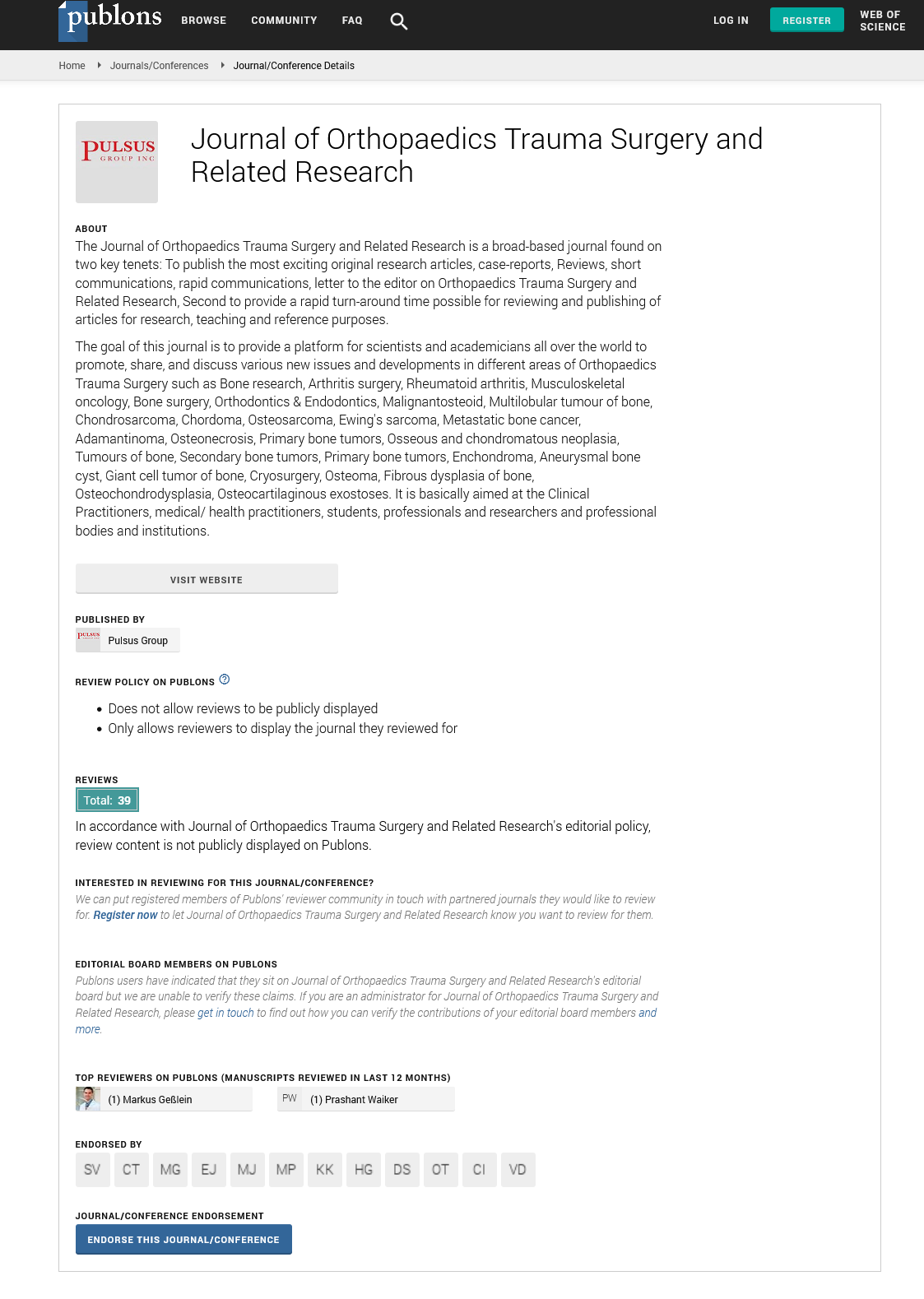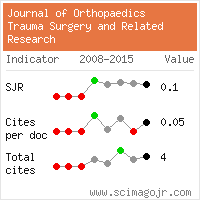Implementing a fracture liaison service: Enhancing post-fracture care for osteoporotic hip and wrist fractures
Received: 22-May-2024, Manuscript No. jotsrr-24-144241; Editor assigned: 25-May-2024, Pre QC No. jotsrr-24- 144241(PQ); Accepted Date: Jun 20, 2024 ; Reviewed: 12-Jun-2024 QC No. jotsrr-24-144241(Q); Revised: 17-Jun-2024, Manuscript No. jotsrr-24- 144241(R); Published: 25-Jun-2024
This open-access article is distributed under the terms of the Creative Commons Attribution Non-Commercial License (CC BY-NC) (http://creativecommons.org/licenses/by-nc/4.0/), which permits reuse, distribution and reproduction of the article, provided that the original work is properly cited and the reuse is restricted to noncommercial purposes. For commercial reuse, contact reprints@pulsus.com
Abstract
Osteoporosis, a condition characterized by decreased bone density and increased fracture risk, poses a significant public health challenge, particularly in ageing populations. Hip and wrist fractures, common among osteoporotic patients, often result in substantial morbidity, mortality, and healthcare costs. The Fracture Liaison Service (FLS) model, an evidence-based, multidisciplinary approach, has emerged as a crucial strategy to improve post-fracture care and reduce subsequent fracture risk. This article examines the implementation and benefits of the FLS model, focusing on its impact on the management of osteoporotic hip and wrist fractures. By integrating coordinated care pathways, enhancing patient education, and optimizing treatment adherence, the FLS model addresses gaps in current osteoporosis management practices and contributes to better patient outcomes.
Keywords
Osteoporosis; Fracture liaison service; Hip fractures
Introduction
Osteoporosis is a prevalent and progressive skeletal disorder that compromises bone strength and increases the likelihood of fractures. According to the World Health Organization (WHO), osteoporosis affects millions of individual’s worldwide, predominantly postmenopausal women and elderly men. The clinical and economic burden of osteoporosis is profound, with hip and wrist fractures being among the most common and debilitating consequences of this condition. Hip fractures, in particular, are associated with high mortality rates and long-term disability, while wrist fractures often lead to chronic pain and functional impairment.
Despite advances in osteoporosis treatment, a significant gap remains in the post-fracture care continuum. Many patients who sustain a fracture are not adequately assessed or treated for underlying osteoporosis, leading to a high risk of subsequent fractures. The Fracture Liaison Service (FLS) model has been developed to address this gap by providing a systematic and coordinated approach to post-fracture care. FLS aims to identify, assess, and treat patients with osteoporosis following a fragility fracture, thereby reducing the risk of future fractures and improving overall patient outcomes. The first step in the FLS model is the systematic identification of patients aged 50 and older who present with fragility fractures. This process typically involves the use of hospital databases, emergency departments, orthopedic clinics, and fracture clinics to identify patients who have sustained fractures. By implementing protocols for the automatic referral of these patients to the FLS, healthcare providers can ensure that no patient is missed. Once patients are identified, a comprehensive clinical assessment is conducted to evaluate their fracture risk. This assessment includes Bone Mineral Density (BMD) testing, usually through Dual-Energy X-ray Absorptiometry (DEXA) scans, to determine the severity of osteoporosis. Additionally, secondary causes of osteoporosis, such as endocrine disorders or medication use, are assessed. Fall risk assessments are also performed to identify any modifiable risk factors for future fractures. Based on the clinical assessment, appropriate osteoporosis treatment is initiated promptly. This treatment may include pharmacotherapy with bisphosphonates, Selective Estrogen Receptor Modulators (SERMs), or other bone-strengthening medications. Lifestyle modifications, such as calcium and vitamin D supplementation, weight-bearing exercises, and fall prevention strategies, are also recommended to enhance bone health and reduce fracture risk. Regular follow-up is a critical component of the FLS model. Patients are monitored to ensure treatment adherence, assess the efficacy of the prescribed therapies, and make any necessary adjustments to the treatment plan. This ongoing support helps to maintain patient engagement and optimize long-term outcomes. The FLS model significantly improves fracture risk assessment by ensuring that all patients with fragility fractures undergo a thorough evaluation for osteoporosis. This comprehensive approach allows for the identification of high-risk patients who might otherwise go undiagnosed and untreated.
FLS programs have been shown to improve treatment adherence among patients with osteoporosis. The structured follow-up and ongoing support provided by FLS coordinators and healthcare professionals help patients to stay on their prescribed treatment regimens, thereby reducing the risk of subsequent fractures. Patient education is a key component of the FLS model. By providing patients with information about osteoporosis, fracture prevention, and the importance of adherence to treatment, FLS programs empower patients to take an active role in managing their bone health. Evidence from clinical studies and real-world implementations has demonstrated that the FLS model effectively reduces the incidence of subsequent fractures. By addressing the underlying osteoporosis and implementing preventive measures, FLS programs help to break the cycle of recurrent fractures that is common among osteoporotic patients. Implementing an FLS program requires significant resources, including trained personnel, funding, and infrastructure. To address these challenges, healthcare systems can explore funding opportunities from governmental and non-governmental organizations, and invest in training programs for healthcare professionals.
The implementation of the Fracture Liaison Service model represents a paradigm shift in the management of osteoporosis and post-fracture care. By offering a structured and proactive approach to identifying and treating osteoporosis in patients who have sustained a fracture, FLS significantly reduces the risk of subsequent fractures and enhances patient outcomes. The benefits of FLS, including improved fracture risk assessment, increased treatment adherence, and better patient education, underscore its critical role in addressing the gaps in current osteoporosis management practices. As healthcare systems worldwide seek to improve the quality of care for osteoporotic patients, the widespread adoption of the FLS model is essential to achieving better health outcomes and reducing the clinical and economic burden of osteoporosis.
Despite the clear benefits, challenges remain in the widespread adoption and implementation of FLS programs. These include resource limitations, variability in healthcare systems, and the need for ongoing education and training of healthcare professionals. However, the success of existing FLS programs provides a compelling case for their broader adoption.
As the global population continues to age, the burden of osteoporosis and fragility fractures will only increase. The FLS model offers a promising solution to this growing public health issue, ensuring that patients receive the comprehensive care they need to manage osteoporosis effectively and prevent future fractures. The integration of FLS into routine clinical practice is essential for improving the quality of care for osteoporotic patients and reducing the clinical and economic impact of this debilitating condition.
Conclusion
The implementation of the Fracture Liaison Service model represents a paradigm shift in the management of osteoporosis and post-fracture care. By offering a structured and proactive approach to identifying and treating osteoporosis in patients who have sustained a fracture, FLS significantly reduces the risk of subsequent fractures and enhances patient outcomes. The benefits of FLS, including improved fracture risk assessment, increased treatment adherence, and better patient education, underscore its critical role in addressing the gaps in current osteoporosis management practices. As healthcare systems worldwide seek to improve the quality of care for osteoporotic patients, the widespread adoption of the FLS model is essential to achieving better health outcomes and reducing the clinical and economic burden of osteoporosis.



 Journal of Orthopaedics Trauma Surgery and Related Research a publication of Polish Society, is a peer-reviewed online journal with quaterly print on demand compilation of issues published.
Journal of Orthopaedics Trauma Surgery and Related Research a publication of Polish Society, is a peer-reviewed online journal with quaterly print on demand compilation of issues published.